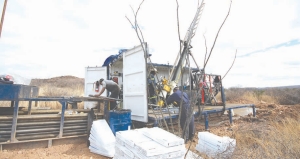VANCOUVER — A successful second phase of exploration at the Cordero property in Chihuahua, Mexico, has expanded two zones and identified several new targets, prompting joint-venture owners Levon Resources (LVN-V) and Valley High Ventures (VHV-V) to commit $14 million to a third phase of drilling and prospecting.
The Cordero property, located near the town of Hildalgo Del Parral, covers a northeast-striking porphyry belt that hosts at least six intrusive centres along its 15-km length. In their first phase of exploration at Cordero, Levon and Valley High discovered two zones: the Pozo de Plata diatreme breccia and the Cordero porphyry. In phase two, the partners expanded both zones, identified six other large targets within the same 6-km segment of the belt through geophysics and sampling, and recognized a separate caldera diatreme complex 7 km southwest along strike that covers 5 sq. km.
Now, in phase three, Levon and Valley High plan to define resources at Pozo de Plata and the Cordero porphyry while also drill-testing the six nearby targets and establishing a better understanding of the new diatreme complex.
The main focus, though, will be on the first of those goals: expanding the two known zones and completing sufficient infill drilling to support a resource calculation. The partners have assigned 50,000 metres of the planned 59,000- metre drill program to this effort. And the final set of results from the previous campaign explains why.
At Pozo de Plata, hole 46 cut 118 metres grading 51 grams silver per tonne, 0.40 gram gold per tonne, 0.41% zinc, and 0.96% lead from 158 metres depth. That hole was collared on the northern edge of the zone, so the hit left Pozo de Plata open to the north. In the western part of the zone, hole 35 returned 100 metres carrying 72.8 grams silver, 0.43 gram gold, 0.97% zinc, and 1.11% lead from 48 metres downhole.
And at the southern edge of the Pozo zone, hole 60 encountered 100 metres grading 31.7 grams silver, 0.08 gram gold, 0.34% zinc, and 0.38% lead from surface, followed by 62 metres averaging 22.3 grams silver, 0.01 gram gold, 2.05% zinc and 0.43% lead from 228 metres depth. This hit leaves the Pozo area open to the south.
Other highlight intercepts from Pozo de Plata include 34 metres of 96.7 grams silver, 0.37 gram gold, 0.91% zinc, and 1.4% lead in hole 37, 54 metres of 111.2 grams silver, 0.58 gram gold, 0.74% zinc, and 1.65% lead in hole 40, and 38 metres grading 82.4 grams silver followed by 10 metres of 148.2 grams silver in hole 45.
The Pozo de Plata zone now stretches along 630 metres strike and across 350 metres width. Drills have tested most of the zone to 325 metres depth. Results to date establish a tabular mineralized diatreme breccia zone that follows northeast-trending rhyolite and dacite dyke swarms. The body is hosted in limestone country rock, which encloses the breccia bodies along irregular and often pipe-like surfaces. The geology documents at least five pulses of mineralization.
Step-out drilling 300 metres to the southwest, in the Josefina zone, and 400 metres to the east, in the Dos Mil Diez diatreme zone, returned diatreme breccia and breccia dyke intercepts. Levon and Valley High believe these two zones are likely extensions of Pozo and expansion drilling towards these zones is part of the upcoming Pozo delineation program.
Over at the Cordero porphyry, which is 1.4 km northeast of Pozo de Plata, the best results came from hole 29. The hole returned half a dozen intercepts, including 12 metres of 60.6 grams silver, 0.49 gram gold, 0.61% zinc, and 0.35% lead from 70 metres depth, followed by 32 metres grading 149.7 grams silver, 0.03 gram gold, 1.48% zinc and 1.72% lead from 116 metres downhole.
The Cordero porphyry hosts classic porphyry-style disseminated and stockwork vein mineralization that stretches across 500 metres width at its north end. The partners believe the nested rhyolite porphyry intrusives present at Cordero may be rooted in a larger mineralized stock at depth.
And at depth to the south drills have started to return veinlet molybdenite mineralization, enveloped by selvages of strong potassic alteration. Levon and Valley High interpret this as evidence of a deeper molybdenum porphyry that cuts the silver-gold-zinc-lead porphyry.
As for the newly recognized caldera diatreme complex, known as Molino de Viento, it sits 7 km southwest of Pozo de Plata or 8.4 km from the Cordero porphyry. The 5-sq.-km area will see mapping, sampling, and follow-up geophysical work during the upcoming program.
Levon owns 51% of Cordero and acts as project operator. Valley High holds the remainder. Both companies have seen their share prices rise significantly, if not smoothly, over the last year: Levon shares have climbed from 20¢ to $1.07 after reaching $1.26 while Valley High has climbed from 20¢ to 80¢ after hitting a high of $1.03. Levon has 63 million shares outstanding; Valley High has 45 million shares.


Be the first to comment on "Levon, Valley High start Cordero’s $14M program"